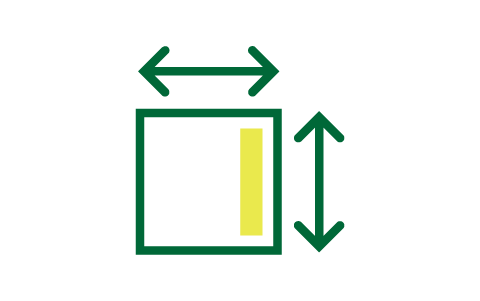
What is The Regenerative Standard?
The Regnerative Standard’s mission is to provide rigorous, straight-forward protocols for nature-based solutions.
The Regenerative Standard has been adopted by Developers on over one million acres as the standard to capture carbon sequestration through regenerative grassland grazing. Version 1.0 was designed to be an on-ramp for ranchers and farmers to gain familiarity with and contribute to global climate mitigation benefits, designed around a rolling 5 year contract period that pays annually for crediting, and requires a 10 yr monitoring tail. Version 1.0 will remain in place as approved to serve the large and growing user-base of acreages registered under this version.
AEI now releases TRS V 2.0, focused on accelerating the scale of use, lengthening the monitoring period to a minimum of 40 years post-crediting period, with additional 100 year or in-perpetuity options. V.2 expands the glossary of terms, provides additional tools to clarify buffering, permanence risk assessments, monitoring, and the quantitative measure-to-measure crediting requirements, while helping encourage project developers and landowners to move to adopting the longer term monitoring commitments.
Nature-positive, high-integrity climate action at scale
The Regenerative Standard’s inaugural protocol is the Soil Carbon Quantification Method, which supports high-quality soil carbon credit generation in a way that is more easily accessible to nature-based project developers and stewards of rangeland, grassland, agricultural, and conservation lands.
New Version 2.0
•
New Version 2.0 •
The Regenerative Standard Version 2.0 is released by Applied Ecological Institute.

Rangeland, Grassland, Agricultural, and Conservation Lands
Public comment is now open for the protocol developed by Applied Ecological Institute, Inc.
Regenerative Soil Organic Carbon Methodology for Rangeland, Grassland, Agricultural, and Conservation Lands V2.0.
This protocol was designed to be an on-ramp for ranchers and farmers to gain familiarity with and contribute to global climate mitigation benefits.
Deadline: May 1, 2025
We encourage community feedback to uphold the transparency and scientific rigor of the Regen Registry.
All comments will be responded to by the methodology developer and published alongside the final protocol in the Regen Registry’s document history.

Objectives of The Regenerative Standard
The Regenerative Standard’s inaugural protocol is the Soil Carbon Quantification Method, which supports high-quality soil carbon credit generation in a way that is more easily accessible to nature-based project developers and stewards of rangeland, grassland, agricultural, and conservation lands.
Easily understood
Measurement and performance-based
Practical and scalable
Land steward-focused
Grounded in science
Open-access and adaptable
“The Regenerative Standard is a welcomed solution to rescue the earth’s climate and other failing ecosystem services. We look forward to a common sense, pragmatic, open and tenaciously disciplined, science-based program to help move land stewards and markets to restoring the earth, food supplies, water, and biodiversity resources.”
Steve Apfelbaum
Founder and Chairman, Applied Ecological Institute

Technical Advisors
Frequently Asked Questions
General VCM Questions
-
A voluntary carbon market is a system that allows individuals, organizations, and companies to purchase and trade carbon credits voluntarily to offset their carbon footprint and support climate change mitigation efforts.
-
In the voluntary carbon market, organizations can purchase carbon credits from projects that have been certified to reduce greenhouse gas emissions. These credits represent one tonne of CO2 equivalent, which can be used to offset an equivalent amount of emissions. Companies or individuals can then retire these credits to claim carbon neutrality or carbon neutrality for specific products, services, or operations.
-
Carbon credits are a tradable commodity representing a reduction or removal of greenhouse gas emissions from the atmosphere. One carbon credit is equivalent to one metric tonne of CO2 or other greenhouse gases.
-
Projects that generate carbon credits can include renewable energy projects, energy efficiency projects, and forest conservation and reforestation projects, among others. These projects are rigorously verified and monitored to ensure their emissions reductions are real, additional, measurable, permanent, and verifiable.
-
By purchasing carbon credits from voluntary carbon markets, companies and individuals can demonstrate their commitment to sustainability and take action to reduce their carbon footprint. Additionally, participating in the voluntary carbon market can support the development of climate change mitigation projects around the world.
-
The price of carbon credits is determined by supply and demand. Prices can vary depending on the project type, location, and certification standard.
-
There are several certification standards used in the voluntary carbon market, including the Regenerative Standard, Gold Standard, Verified Carbon Standard, and Climate, Community & Biodiversity Standards. These standards ensure the credibility of the carbon credits generated from the projects.
-
Carbon credits are not regulated, but they are subject to certification standards and voluntary codes of conduct to ensure their integrity and credibility.
About the Regenerative Standard
-
The Regenerative Standard is governed by Applied Ecological Institute, a 501(c)(3) nonprofit organization. Our vision is to understand the needs of land stewards by providing straightforward protocols that are backed by science, to incentivize and scale regenerative land management and restoration practices to create carbon drawdown offsets, provide reliable, defensible carbon storage, and deliver benefits beyond carbon. We also offer a registry that certifies high-quality, measured carbon drawdown offsets with the full transparency and auditability expected by carbon buyers.
-
Nature-based carbon solutions are necessary to rapidly scale the participation and incentivize land steward behavior and performance changes to address the climate mitigation needs.
Many standards describe how carbon credits from nature-based carbon storage can be generated. However, few standards combine a strong emphasis on carbon removal credit quality while also making it easier for landowners to participate in nature-based carbon storage opportunities at scale. -
Project Developers and Land Stewards - who manage ecological impact projects, track ecological assets, and issue carbon offsets and credits.
Verifiers and Validators - who confirm that all emission reductions or removals are quantified according to the Standard’s requirements.
Corporations and Individuals - who mitigate environmental degradation as an approach to corporate social responsibility and achieve their climate accord commitments.Methodology Designers and Scientists - who define and govern ecological asset standards.
-
Any project must demonstrate additionality and document one of two options. Option One is based on Verra’s traditional definition of additionality. Option Two is based on BCarbon’s definition of additionality and is more applicable to the land use of agriculture and grazing transitioning to regenerative and restorative practices. Absent a climate-smart agriculture data set that includes a comprehensive mix of specific soil types, climate and locational contexts, practice types, and crop types, the Regenerative Standard’s approach to carbon credits simply incentivizes land stewards to go above and beyond their current practices to support measured outcomes.
-
The Standard allows a more pragmatic, but shorter carbon storage permanence term of at least 10 years after each issuance of carbon credits. For example, if a land steward enrolls in carbon projects with contractual participation of at least 5 years, the total project permanence is at least 15 years (5 years of accrual + 10 years of storage). Permanence terms could be longer if the project developer enrolls land stewards with a longer contractual term. All project developers are required to document the project permanence term with the Registry.
-
Under the Regenerative Standard, no offset credit is currently awarded for reductions in GHGs associated with reduced agricultural inputs such as fertilizers and pesticides, reduced usage of powered farm equipment, or reduced emissions from livestock or manure operations. This makes this Standard inherently conservative in terms of the number of credits issued.For reasonable and sufficient assurance that carbon pools and GHG emissions are not changing for the project scenario, the project proponent is required to determine, at a minimum, the likelihood of the project activities leading to an increase in GHG emissions either within the project area or outside the project area based on consideration of the most important GHG emissions related to operations in agricultural, grazing and conservation lands.
-
The Regenerative Standard currently only quantifies carbon removal (drawdown) credits.Most soil carbon protocols credit some combination of carbon removal and avoided emissions, including CO₂ emissions unrelated to soil carbon (e.g. tractor use), and in some cases other greenhouse gases like N₂O and CH₄ that result from fertilizer use, grazing animals, or anaerobic decomposition. No protocols track carbon removal and avoided emissions separately, so buyers looking to focus exclusively on carbon removal must decipher this distinction themselves. To help make this distinction explicit, the Regenerative Standard currently applies only to carbon removal credits and does not include any benefits from “avoided emissions” credits.
Stakeholder Questions
-
Carbon credit buyers seek sterilized credits that have gone through the Regenerative Standard’s rigorous assessment process to generate offsets that are not only additional, permanent, and resilient to leakage, but also credits that are accurately calculated, not claimed by another entity, transparently retired, and have not caused any social harm as verified by independent, third-party verifiers and transparently registered and retired on the Regenerative Registry.
Verifiers & Other Partners
-
Partners include providers of Measurement, Reporting, and Verification (MRV) services. The Regenerative Standard provides clear and specific guidance to streamline the verification process and ensure that data, technology, calculations, confidence factors, and uncertainty calculations are reasonable and appropriate to ensure credit delivery and reduce the probability of shortfall. In addition to easy-to-follow checklists, the Regenerative Standard created a Verification Program Manual to guide verifiers with a standardized approach to the independent and rigorous verification of GHG removals reported by project developers into its offset program.
-
Projects are verified by an independently approved verifier, who had a PhD soil ecologist on staff prior to submission to the Regenerative Registry. To prevent conflicts of interest, no organization can provide verification for any projects where they function as the soil sampling contractor. Any MRV company who is approved and in good standing in existing offset registries (e.g. Climate Action Reserve, American Carbon Registry, and Verra) can verify Regenerative Standard carbon removal claims. Today, verifiers include but are not limited to Earth Optics, SCS Global, Ruby Canyon, and Aster Global.
Project Developer & Project Proponents
-
Project developers have a key role in keeping abreast of relevant documents, processes, and procedures to register, approve and run cost-effective soil carbon projects. The Regenerative Standard provides clear and straightforward checklists for validation and verification that better enables project developers to manage projects in both a time- and cost-effective way. It also allows forward-looking assessments and ex-ante crediting that gives them a more consistent cash flow.
-
If so, how much and are pooled credits released back to the project? A percentage of project carbon credits are reserved by the Credit Registry to ensure that Interim Carbon Credits in the forward assessment are not overstated. This is addressed with a buffer. The number of credits withheld in a buffer pool is determined by one of the following: Option 1 - Retainage: 10% of the credits issued from the project will be withheld in a buffer account and released at the end of the crediting period of no shortfall during the crediting period occurs and minimal disturbance occurred during the storage period. Option 2 - Pooling: The number of buffer credits to be contributed to the Agriculture, Forestry, and Other Land Use (AFOLU) pooled buffer account can be determined by applying the latest version of the VCS AFOLU Non-Permanence Risk Tool. Pooling only applies to contracts with a greater than 25-year commitment.
Land Stewards
-
Land stewards want the simplicity and trustworthiness of the Regenerative Standard that aligns with the goals of their land, regenerative agriculture, and succession plans. The Regenerative Standard also allows for earlier payments to reward land stewards for their regenerative agriculture practices that accelerate the regeneration and restoration of the land.And according to Farm Journal, land stewards justifiably want "trust that carbon-marketplace partners intend to recognize the total value of their farm operation and to compensate them appropriately." This requires bundling co-benefits into the price of a cohesive ecosystem service payment, which includes carbon sequestration. The Regenerative Standard is designing other ecosystem credits to increase the revenue potential for land stewards enough to make it more financially viable and attractive to transition to regenerative practices.
-
Yes. The Regenerative Standard can be used in cropland, grassland, and rangeland ecosystems.
Registering, Purchasing, & Retiring Regen Credits
-
The Regenerative Registry is a separate entity from the Regenerative Standard and is the only current registry supporting credits from the Regenerative Standard. The Regenerative Registry requires independent, 3rd-party verification to certify and issue credits. Visit regenerativeregistry.org for more details.
-
There is no fee to use the Regenerative Standard per se. It only provides a process for land stewards and project developers to use regenerative land management and restoration practices to create carbon drawdown credits and ecological co-benefits through nature-based solutions that provide reliable, quantifiable, and durable results. There are, however, transaction fees for the issuance and registration of carbon and other ecosystem credits generated from the Regenerative Standard.
Participating in the Regenerative Standard’s Future
-
To comment and contribute to the current and future versions of the Regenerative Standard, visit regenerativestandard.org/contact.
-
There are no restrictions on who may comment during public review periods. We hold a 30-day public review and comment period during the development process for each of our protocols. We distribute the notice of the public review period to the newsletter distribution list and account holders. During the public review period, we also hold an in-person or virtual public workshop with conference call and webcast capabilities. Click here to add your email address to our distribution list.
-
The Standard uses an intensive, multi-stakeholder process to develop its standardized project protocols. Developing a new protocol generally takes 9 to 12 months from start to finish. Once the development process is initiated with the formation of a workgroup, the protocol in development will have its own webpage with additional information on timeline, workgroups, contact information, background resources, contribution opportunities, etc.










